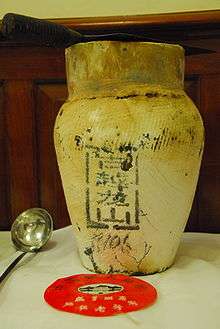Shaoxing wine
| Shaoxing wine | |||||||||||||||
 A smaller scaled version of the classic Shaoxing wine container | |||||||||||||||
| Traditional Chinese | 紹興酒 | ||||||||||||||
|---|---|---|---|---|---|---|---|---|---|---|---|---|---|---|---|
| Simplified Chinese | 绍兴酒 | ||||||||||||||
| |||||||||||||||
Shaoxing wine (Shaohing, Shaoshing) is one of the most famous varieties of huangjiu, or traditional Chinese wines, fermented from rice. It originates from the region of Shaoxing, in the Zhejiang province of eastern China. It is widely used as both a beverage and a cooking wine in Chinese cuisine. It is internationally well known and renowned throughout mainland China, as well as in Taiwan and Southeast Asia.[1]
Production
Shaoxing wine has been in production since dynastic times. Large quantities are made and stored in the classic Shaoxing wine container over long periods of time.[1] It is also bottled for domestic consumption and for shipping internationally. Aged wines are referred to by year of brewing, similar to grape vintage year (chénnián, 陳年).
Classification
| Classification[2] | ||||
|---|---|---|---|---|
| Name (in Chinese) | Literal translation | Sugar content (g/L) | Type | % Ethanol |
| yuanhongjiu 元红酒 | Premier red wine | < 5 | Dry wine | > 14.5 |
| jiafanjiu 加饭酒 = huadiaojiu 花雕酒 | Wine with added rice Wine in jar, engraved with flowers | 5–30 | Semi-dry wine | > 16.0 |
| shanniangjiu 善酿酒 | Well-fermented wine | 30–100 | Sweet wine (moelleux) | >15.0 |
| xiangxuejiu 香雪酒 = fenggangjiu 封缸酒 | Snow-flavored wine Jug wine | 200 | Sweet wine (doux) | >13.0 |
Usage
Shaoxing wine can be drunk as a beverage and is considered to take the place of rice at the beginning of a meal. When at home, some families will drink their wine out of rice bowls, which is also the serving style at Xian Heng Jiu Dian (see link below). Women customarily do not drink very much, as it is considered somewhat unbecoming. If not served at a meal, Shaoxing wine can also accompany peanuts or other common snacks.
Huang jiu 黄酒, as it is known locally, is also well known for its use in meat dishes, in addition to being an ingredient in many dishes of Chinese cuisine. It is a key ingredient of Mao Zedong's favourite dish of braised pork belly with scallion greens - what he called his "brain food" that helped him defeat his enemies.[3] The following is a sample list of other common Shaoxing wine-marinated dishes. It is not limited to the following:[1]
- Drunken chicken (醉雞)
- Drunken shrimp (醉蝦)
- Drunken gizzard (醉腎)
- Drunken fish (醉魚)
- Drunken crab (醉蟹)
- Drunken liver (醉肝)
- Drunken tofu (醉豆腐乾)
- Drunk phoenix talon (醉鳳爪)
Producers
One prominent producer of Shaoxing wine is Zhejiang Gu Yue Long Shan Shaoxing Wine Co., Ltd. (古越龍山) of Shaoxing, Zhejiang.[4] Other popular brands include: Di ju tang 帝聚堂, Kuai ji Shan 会稽山 (named after a local mountain), and Tu Shao Jiu 土绍酒.
See also
References
- 1 2 3 TVB show Natural Heritage 天賜良源 episode 1 January 30, 2008. Shaoxing wine exclusive
- ↑ Lee, Yuan-Kun (2006). Microbial Biotechnology: Principles and Applications (2nd revised ed.). World Scientific. ISBN 9812566767.
- ↑ Malcolm Moore (29 January 2010). "China sets standard for Chairman Mao's favourite dish". Daily Telegraph. Retrieved 5 February 2012.
- ↑ Shaoxingwine.com